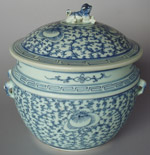
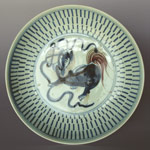
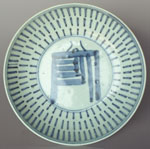
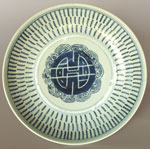
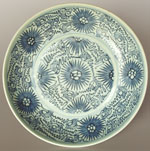


| Discovering Asia's ceramic development |
 |
 |
 |
 |
 |
 |
 |
 |
 |
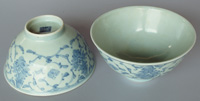 |
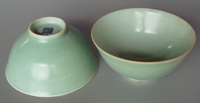 |
 |
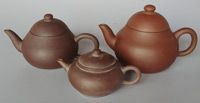 |
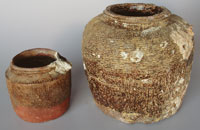 |
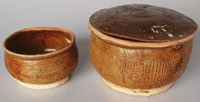 |
This wreck was discovered in 20 metres of water, close to the coast of Johor. Excavation was under way when the exhibition opened, and was completed in 2002: see Desaru ship report. The estimated date of wrecking has been revised to the 1840s, somewhat later than original assessments, following the uncovering of a date 1840 on the single cannon recovered.
The ship appears to have been about 30 metres in length and 8 metres wide. The hull is of pine and there are transverse bulkheads made of cedar. Neither of these timbers grows in Southeast Asia; the temperate-climate wood and transverse bulkheads show that the ship was built in China. All of the ceramics on board are Chinese, and all of the high-fired ceramics are blue-and-white (no celadon).
The Desaru sank 2-3 decades later than the Diana (1817, near Malacca), but some of their blue-and-white ceramics are identical. The Diana cargo was however made mainly to order, for the European community in India, whence she came. The Desaru ceramics were made for the Southeast Asian markets, where traditional forms and decoration were appreciated. They include Yixing teapots, of the brown stoneware favoured by tea connoisseurs. Whole tea sets, including covered bowls, cups and serving trays, were probably intended for the Chinese community at Malacca. 'Lion-dog' (dog of Fu) dishes, longevity plates, and lotus-decorated bowls from Jingdezhen are examples of the Desaru's Southeast Asian style pottery.
The Chinese blue-and-white ceramics are in excellent condition. Visitors to the exhibition will be able to compare the glossy surface with products from the Xuande. Perfected technique and very high firing temperature are the main factors in this high quality.
The 'lion dog' in the first plate on the left has now become highly stylised, and appears to have incorporated some features of the mythical qilin. (The dog is facing to the left, and has its head twisted up as if in a lion dance - which might explain the ribbons. The tail is red.) Compare with the more traditional dogs on the 16th-century Xuande.
The stick-like symols arrayed in four rings around the cavetto of the liondog plate are stylised Sanskrit characters for the sacred syllable om. The om character itself is shown in the medallion of the next plate, again surrounded by tiers of the stylised version. (This plate is from the Dehua kilns; the others shown are from Jingdezhen.) Similar designs were found on the Diana.
The third plate has the seal-script version of the character shou, 'long life', encircled by ju-yi lappets, and again surrounded by stylised om characters. This longevity plate is also very similar to examples from the Diana.
Over fifty thousand ceramic spoons were recovered. The cargo also contained bowls, but less than one-tenth the number. This implies that bowls may have been shipped separately, casting interesting light on the scale of the trade.
The blue and white bowls shown first on the right are from Jingdezhen. They have everted rims, and are decorated with a lingzhi fungus motif at the centre, a fungus scroll at the rim, and lotus scroll above a band of lotus petals on the exterior. The bowls shown next, of unknown origin, have similar decoration, but only in outline, without fill, and their rims are straight.
The celadon bowls from Jingdezhen are undecorated, but for a potter's mark. The underglaze decorated bowls shown next, with four stylised flowers around the exterior, are from Guangdong. The interior has a circular patch of glaze in the centre, surrounded by an unglazed ring.
The teapots from Yixing are of classic design, and have a variety of potter/pottery marks on the base. Some relate to the 17th century Hui Mengchen, and are clearly spurious. One has been identified as the mark of Shao Youlan, active in the 19th century.
Green-glazed covered boxes from Yixing, such as the set on the left, were said to emulate Jun ware, prized imperial ceramics dating from the Southern Song dynasty.
Many storage jars have been recovered. Some would have been required for fresh water; others were found packed with Yixing teapots and small ceramic items.
| Exhibition index |